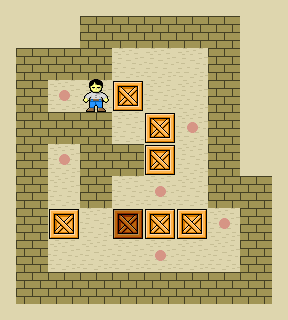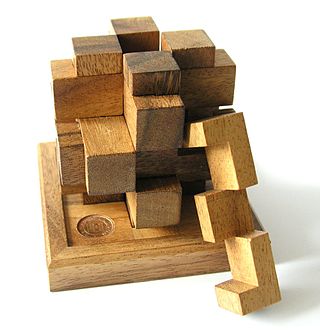
Puzzle video games make up a broad genre of video games that emphasize puzzle solving. The types of puzzles can test problem-solving skills, including logic, pattern recognition, sequence solving, spatial recognition, and word completion. Many puzzle games involve a real-time element and require quick thinking, such as Tetris (1985) and Lemmings (1991).

Sokoban is a puzzle video game in which the player pushes boxes around in a warehouse, trying to get them to storage locations. The game was designed in 1981 by Hiroyuki Imabayashi, and first published in December 1982.
A puzzle is a game, problem, or toy that tests a person's ingenuity or knowledge. In a puzzle, the solver is expected to put pieces together in a logical way, in order to arrive at the correct or fun solution of the puzzle. There are different genres of puzzles, such as crossword puzzles, word-search puzzles, number puzzles, relational puzzles, and logic puzzles. The academic study of puzzles is called enigmatology.

A team is a group of individuals working together to achieve their goal.

A mechanical puzzle is a puzzle presented as a set of mechanically interlinked pieces in which the solution is to manipulate the whole object or parts of it. While puzzles of this type have been in use by humanity as early as the 3rd century BC, one of the most well-known mechanical puzzles of modern day is the Rubik's Cube, invented by the Hungarian architect Ernő Rubik in 1974. The puzzles are typically designed for a single player, where the goal is for the player to discover the principle of the object, rather than accidentally coming up with the right solution through trial and error. With this in mind, they are often used as an intelligence test or in problem solving training.

Disentanglement puzzles are a type or group of mechanical puzzle that involves disentangling one piece or set of pieces from another piece or set of pieces. Several subtypes are included under this category, the names of which are sometimes used synonymously for the group: wire puzzles; nail puzzles; ring-and-string puzzles; et al. Although the initial object is disentanglement, the reverse problem of reassembling the puzzle can be as hard as—or even harder than—disentanglement. There are several different kinds of disentanglement puzzles, though a single puzzle may incorporate several of these features.

Team building is a collective term for various types of activities used to enhance social relations and define roles within teams, often involving collaborative tasks. It is distinct from team training, which is designed by a combine of business managers, learning and development/OD and an HR Business Partner to improve the efficiency, rather than interpersonal relations.
Mathematical puzzles make up an integral part of recreational mathematics. They have specific rules, but they do not usually involve competition between two or more players. Instead, to solve such a puzzle, the solver must find a solution that satisfies the given conditions. Mathematical puzzles require mathematics to solve them. Logic puzzles are a common type of mathematical puzzle.

Zoombinis was a series of educational puzzle computer games that were originally developed by TERC and published by Broderbund. In 1998, Broderbund was purchased by The Learning Company, who took responsibility for developing and publishing the series in 2001. The series consists of three games: Logical Journey of the Zoombinis (1996), Zoombinis: Mountain Rescue (2001), and Zoombinis: Island Odyssey (2002). Logical Journey was remade as Zoombinis for modern operating systems in 2015. The series focuses on the Zoombinis, small blue creatures each with different appearances and personalities, which the player must guide through strange puzzle-filled lands.

Induction puzzles are logic puzzles, which are examples of multi-agent reasoning, where the solution evolves along with the principle of induction.
God's algorithm is a notion originating in discussions of ways to solve the Rubik's Cube puzzle, but which can also be applied to other combinatorial puzzles and mathematical games. It refers to any algorithm which produces a solution having the fewest possible moves. The allusion to the deity is based on the notion that an omniscient being would know an optimal step from any given configuration.
Size is an important characteristic of the groups, organizations, and communities in which social behavior occurs.

Real World/Road Rules Challenge: Fresh Meat is the 12th season of the MTV reality game show, The Challenge.

A game is a structured form of play, usually undertaken for entertainment or fun, and sometimes used as an educational tool. Many games are also considered to be work or art.

Picross 3D, known in Japan as Rittai Picross, is a puzzle video game developed by HAL Laboratory and published by Nintendo for the Nintendo DS. It was released in Japan in March 2009, in Europe in March 2010, and in North America in May 2010. It uses similar nonogram mechanics to Picross DS, but it puts it in 3D. Outside Japan, the game is part of Nintendo's Touch! Generations brand. A sequel, Picross 3D: Round 2, was released for the Nintendo 3DS in Japan in October 2015, in North America in September 2016, and in Europe and Australia in December 2016.
NoviCraft is a 2008 video game developed by LudoCraft Ltd. and published by TeamingStream Ltd. It is a resource which aims to support business customers in social excellence, and learn to construct shared understanding with different people in changing contexts. It is a total conversion mod for virtual engagement which was commercially released in 2008. The game's first generation was developed in 2002 for research purposes at the University of Oulu, Finland to test whether computer games could be used for learning. In 2009, NoviCraft was granted the "best e-learning solution of the year" award during a competition hosted by Finland's E-learning Center (E-oppimiskeskus).

Puzzle & Dragons is a puzzle video game with role-playing and strategy elements, developed and published by GungHo Online Entertainment for the iOS, Android, and Amazon Fire platforms.

The Challenge: Champs vs. Pros is a special mini-series of MTV's long-running reality game show, The Challenge. In the six-week event, ten Challenge greats competed against ten professional athletes. The series premiered on Tuesday, May 16, 2017, and concluded on June 20, 2017. The series was hosted by NFL wide receiver Victor Cruz. Contestants competed to win $50,000 to donate to the charity of their choice. In 2017 the series format was changed to include celebrities and was renamed Champs vs. Stars.

The first season of The Challenge: All Stars premiered on Paramount+ on April 1, 2021. The season featured twenty-two cast members from The Real World, Road Rules and The Challenge competing for $500,000.

The first season of The Challenge: USA premiered on CBS on July 6, 2022. The season featured twenty-eight cast members from Big Brother, Love Island, Survivor, and The Amazing Race competing for a monetary prize.















